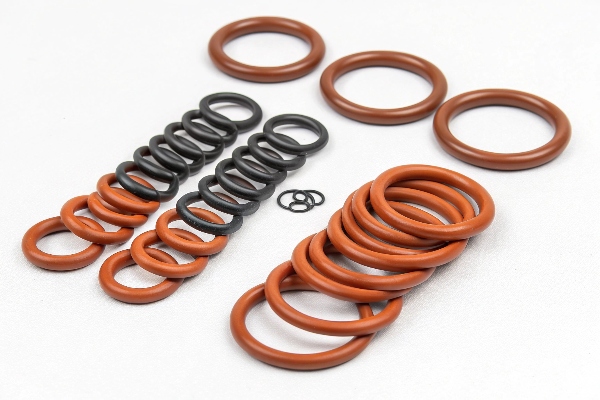Have you ever chosen NBR rubber for seals and regretted unexpected issues later? Selecting materials without knowing pros and cons can ruin projects quickly.
NBR rubber provides excellent oil, fuel, and abrasion resistance at low costs, but it struggles against ozone, UV rays, and harsh solvents, limiting outdoor and certain chemical applications.

Knowing the full picture about NBR rubber is essential. Let's dive deeper to see if NBR rubber truly matches your needs, or if you might need an alternative.
What are the Advantages of NBR Rubber?
Have you dealt with leaking seals because of oil or fuel exposure? You're not alone. That's exactly why my client, Jet from the Netherlands, switched to NBR for many HVAC applications.
NBR rubber offers excellent resistance to oils, fuels, and petroleum-based products, strong abrasion resistance, and impressive compression set. It’s also cost-effective, easy to fabricate, and performs reliably between -40°C to 120°C.
Understanding Key Advantages of NBR Rubber
Let's clarify why NBR is popular in the sealing industry.
✅ Excellent Oil and Fuel Resistance1
NBR's resistance to petroleum-based oils is unmatched in many sealing applications. This is critical for automotive and hydraulic industries, where seals regularly contact oil and fuel. One of my key clients, Jet from the Netherlands, significantly reduced warranty returns by adopting NBR seals.
✅ High Abrasion Resistance
NBR handles repeated friction exceptionally well. It's ideal for dynamic seals that face constant movement, ensuring longer service life.
✅ Great Compression Set
Compression set shows how well rubber keeps its shape under pressure. NBR scores very high here, maintaining sealing integrity even under long-term compression.
✅ Cost-Effective Production2
For businesses like Jet’s, which balance high quality with competitive pricing, NBR is ideal. It provides reliable performance without breaking budgets.
Here's a clear breakdown:
| Advantage | Industrial Benefit |
|---|---|
| ✅ Oil/Fuel Resistance | Prevents leaks, suitable for automotive |
| ✅ Abrasion Resistance | Durable in dynamic applications |
| ✅ Compression Set | Reliable long-term sealing |
| ✅ Cost-Effective | Ideal for large-volume production |
What are the Disadvantages of NBR Rubber?
Are your rubber products failing outdoors or in harsh chemicals? You might be experiencing NBR’s weaknesses.
NBR rubber has poor weathering and UV resistance, low tolerance to strong solvents like acetone, limited performance beyond 120°C, and environmental concerns due to petroleum-based materials.
Addressing NBR's Main Drawbacks
❌ Poor UV and Ozone Resistance3
Outdoors, NBR deteriorates quickly when exposed to ozone and sunlight. This makes NBR unsuitable for external seals in HVAC or outdoor equipment.
❌ Sensitive to Harsh Chemicals
Strong acids, alkalis, ketones, and chlorinated solvents severely damage NBR. I once helped Jet solve a chemical compatibility issue after realizing NBR was unsuitable for acetone-based cleaners used onsite.
❌ Limited Temperature Range
Beyond 120°C, NBR loses elasticity. This limits its use in high-temperature machinery. For extreme conditions, silicone or FKM would perform better.
❌ Sustainability Concerns
NBR production relies heavily on petroleum resources, making it less eco-friendly. This aspect could affect sustainability-focused industries.
When to Avoid NBR Rubber?
To simplify decision-making, here's a table clearly showing when to reconsider using NBR:
| Condition | Why Avoid NBR? | Suggested Alternatives |
|---|---|---|
| Outdoor Use | Rapid ozone and UV degradation | EPDM, Silicone |
| Chemical Exposure | Quickly damaged by solvents | Viton (FKM) |
| High-Temperature (>120°C) | Loses mechanical strength | Silicone, FKM |
| Sustainability Required | Petroleum-based production | Bio-based or recycled rubbers |
What Applications are Best Suited for NBR Rubber?
Are you still unsure if NBR is right for your project? Let’s clearly define NBR's ideal use-cases.
NBR is best suited for automotive seals, oil-resistant hoses, industrial gaskets, and HVAC sealing systems, particularly where oil and abrasion resistance are essential.
Ideal NBR Rubber Applications
From my extensive experience exporting to Germany, France, and the Netherlands, these applications benefit most from NBR:
- Automotive Industry: Oil seals, fuel lines, and hoses.
- Hydraulic Systems: O-rings, gaskets, and seals in machinery.
- HVAC Industry: Compressor seals, oil-resistant gaskets.
- Industrial Equipment: Conveyor belts and rollers needing abrasion resistance.
Application Decision Guide:
| Industry | Recommended Use Cases |
|---|---|
| Automotive ✅ | Oil seals, fuel system seals, gaskets |
| Hydraulic Systems ✅ | O-rings, hoses, pump seals |
| HVAC ✅ | Compressor gaskets, oil-resistant seals |
| Industrial ✅ | Abrasion-resistant conveyor rollers |
How Does NBR Rubber Compare to EPDM and Silicone?
Not sure whether to choose NBR, EPDM, or Silicone? I faced similar confusion before fully understanding their differences clearly.
NBR rubber is oil-resistant and affordable; EPDM excels outdoors with excellent UV resistance; Silicone performs well at extreme temperatures and offers superior environmental stability.
Technical Comparison of NBR, EPDM, and Silicone 🛠️
Here's a clear comparison table for selecting the right material:
| Properties | NBR | EPDM | Silicone |
|---|---|---|---|
| Oil Resistance | ✅ Excellent | ❌ Poor | Moderate |
| UV/Ozone Resistance | ❌ Poor | ✅ Excellent | ✅ Excellent |
| Temperature Range | -40°C to 120°C | -50°C to 150°C | -60°C to 230°C |
| Abrasion Resistance | ✅ Excellent | Good | Moderate |
| Chemical Resistance | Moderate | Good (no oils) | Moderate to excellent |
| Cost | ✅ Economical | Economical | Higher cost |
Choosing correctly avoids failures and keeps Jet’s business running smoothly without costly interruptions.
Conclusion
NBR rubber is ideal for oil resistance and cost-effective solutions but consider its UV and chemical weaknesses carefully to avoid future issues.
🚀 Ready to Order or Need Advice?
Contact me at info@rubberandseal.com or visit Julong Rubber for expert recommendations, custom quotes, or personalized guidance from our sales team today!
-
Understanding the benefits of oil and fuel resistance can help you choose the right materials for your applications, ensuring durability and performance. ↩
-
Learning about cost-effective production can guide you in selecting materials that balance quality and budget, optimizing your projects. ↩
-
Exploring UV and ozone resistance will help you make informed decisions about outdoor applications and material longevity. ↩








